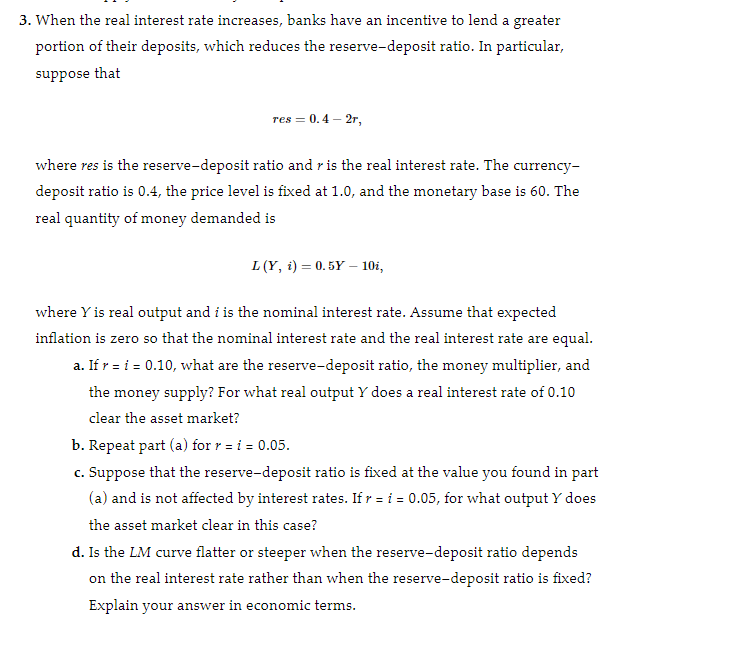
3. When the real interest rate increases, banks have an incentive to lend a greater portion of their deposits, which reduces the reserve-deposit ratio. In particular, suppose that res = 0.4-2r, where res is the reserve-deposit ratio and r is the real interest rate. The currency- deposit ratio is 0.4, the price level is fixed at 1.0, and the monetary base is 60. The real quantity of money demanded is L (Y, i) = 0.5Y - 10i, where Y is real output and i is the nominal interest rate. Assume that expected inflation is zero so that the nominal interest rate and the real interest rate are equal. a. If r = i = 0.10, what are the reserve-deposit ratio, the money multiplier, and the money supply? For what real output Y does a real interest rate of 0.10 clear the asset market? b. Repeat part (a) for r = i = 0.05. c. Suppose that the reserve-deposit ratio is fixed at the value you found in part (a) and is not affected by interest rates. If r = i = 0.05, for what output Y does the asset market clear in this case? d. Is the LM curve flatter or steeper when the reserve-deposit ratio depends on the real interest rate rather than when the reserve-deposit ratio is fixed? Explain your answer in economic terms. 3. When the real interest rate increases, banks have an incentive to lend a greater portion of their deposits, which reduces the reserve-deposit ratio. In particular, suppose that res = 0.4-2r, where res is the reserve-deposit ratio and r is the real interest rate. The currency- deposit ratio is 0.4, the price level is fixed at 1.0, and the monetary base is 60. The real quantity of money demanded is L (Y, i) = 0.5Y - 10i, where Y is real output and i is the nominal interest rate. Assume that expected inflation is zero so that the nominal interest rate and the real interest rate are equal. a. If r = i = 0.10, what are the reserve-deposit ratio, the money multiplier, and the money supply? For what real output Y does a real interest rate of 0.10 clear the asset market? b. Repeat part (a) for r = i = 0.05. c. Suppose that the reserve-deposit ratio is fixed at the value you found in part (a) and is not affected by interest rates. If r = i = 0.05, for what output Y does the asset market clear in this case? d. Is the LM curve flatter or steeper when the reserve-deposit ratio depends on the real interest rate rather than when the reserve-deposit ratio is fixed? Explain your answer in economic terms







